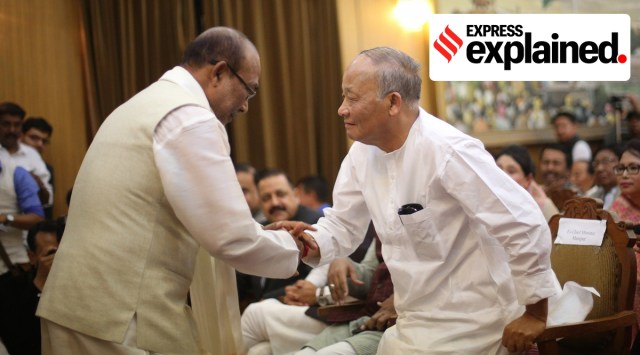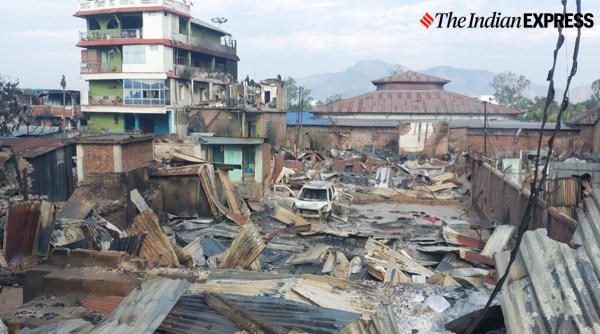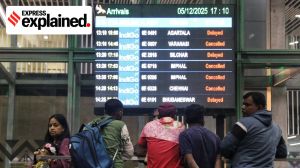Who are the Meitei, Manipur’s valley-dwellers with an old and rich history?
Much of the Meitei insurgency is rooted in its history, and is replete with echoes of re-establishing the glory of the ancient Manipur kingdom. The loss of identity, and the struggle to restore it, remains at the heart of the Meitei movement, and is foundational in Manipuri society.
 Both Chief Minister N Biren Singh (left) and his predecessor O Ibobi Singh are Meitei Kshatriyas. (Archive)
Both Chief Minister N Biren Singh (left) and his predecessor O Ibobi Singh are Meitei Kshatriyas. (Archive) The trigger for the violent clashes in Manipur was a contentious order of the High Court that boosted a longstanding demand by the valley-dwelling Meiteis to be designated as a Scheduled Tribe in order to protect their “ancestral land, traditions, culture and language”. Protests by tribal groups against the HC order in all the hill districts on May 3 led to violence, first in Kuki-dominated Churachandpur, and then in the Imphal valley.
Social scientists in Manipur said a long history of invasions, plunder, and loss of identity — including as a result of assimilation with the outside world — of the Meitei, originally subjects of the thousands-of-years-old Manipuri kingdom, cannot be uncoupled from the recent incidents.
As such, the scars from the ethnic violence between the Meitei and Kuki, in which at least 60 people have been killed so far, are unlikely to disappear soon.
 Meiteis protest against the ongoing clashes in Manipur, at Jantar Mantar in New Delhi on Friday. The Northeastern state has seen widespread violence over the past couple of days. PTI
Meiteis protest against the ongoing clashes in Manipur, at Jantar Mantar in New Delhi on Friday. The Northeastern state has seen widespread violence over the past couple of days. PTI
The origin story
The Cheitharol Kumbaba, royal chronicles of Manipur that are the primary source of information on its early rulers, trace the origin of the Meitei kingdom of Kangleipak to 33 AD. The Meiteis are divided into seven Salai or clans — Mangang, Luwang, Khuman, Angom, Moirang Kha, Ngangba, and Sarang Leishangthem. An unbroken line of kings of the Ningthouja dynasty, belonging to the Mangang clan, ruled until 1955, and Pakhamba, the serpent king from whom the dynasty claimed descent, remains the presiding deity of Manipur and symbols of Pakhamba — a snake with its tail in its mouth — are seen all over the Imphal valley, in offices, homes, temples, restaurants, and the palace.
Imphal-based historians have contended that the Kangleipak lands extended beyond the Imphal valley — comprising the five present-day districts of Imphal East, Imphal West, Thoubal, Bishnupur, and Kakching — but the tribes of the hill districts have contended they were always independent entities.
 Vehicles in flames after violence broke out during the ‘Tribal Solidarity March’ called by All Tribal Student Union Manipur (ATSUM), in Imphal, Thursday, May 4, 2023. (PTI Photo)
Vehicles in flames after violence broke out during the ‘Tribal Solidarity March’ called by All Tribal Student Union Manipur (ATSUM), in Imphal, Thursday, May 4, 2023. (PTI Photo)
Arrival of Hinduism
The Hindu religion first appeared in Manipur in the late 15th century. The Maharaja of Manipur was gifted an idol of Vishnu on Garuda, which he installed in a temple in Bishnupur. The idol no longer exists, but the name it gave the district persists.
Author and former IAS officer Dr R K Nimai said Vaishnavism took root in Manipur in phases, as Bengali Hindu monks and laity fleeing persecution under the sultans of Bengal came to Manipur, built temples, and became integrated into Manipuri society.
In the early 18th century, the Meitei king Pamheiba made Hinduism the kingdom’s official religion, leading to the gradual decline of the ethnic polytheistic Sanamahi religion. The king also encouraged the use of the Bengali script, and ordered the Sanamahi scripture Puyas written in it.
As assimilation progressed, the Manipuri Goddess Panthoibi became Durga, and aspects of the ancient festival and dance Lai Haraoba were incorporated into Manipur’s famous Ras Lila.
 Destruction raged throughout Haokip Veng as ethnic violence rocked Manipur over the last 3 days. (Express Photo: Jimmy Leivon)
Destruction raged throughout Haokip Veng as ethnic violence rocked Manipur over the last 3 days. (Express Photo: Jimmy Leivon)
Caste in Manipur
With Hinduism came caste and, over time, three broad categories emerged.
There were the Bahmons (Brahmans) many of whom are believed to be outsiders who settled in Manipur and married local women. Bahmons could be priests who performed rituals, or cooks who produced meals during Meitei festivals and ritual feasts.
The Kshatriyas were converts to Hinduism, who took the surname Singh. Both Chief Minister N Biren Singh and his predecessor Okram Ibobi Singh of the Congress are Kshatriyas.
Those who continued to follow the pre-organised religion practices of ancestor worship became the Scheduled Castes. They live mainly in Andro in Imphal East and Sekmai and Phayeng in Imphal West, and are traditional brewers of local rice wine.
Then there are the “RKs” — Rajkumars and Rajkumaris — who are part of Manipur’s original nobility and claim to be direct descendants of Pakhamba.
History of war
During the “Seven Years Devastation” from 1819 to 1826, forces of the Burmese kingdom occupied Manipur, and king Marjit Singh fled to Cachar. After the first Anglo-Burmese war, Gambhir Singh was installed as Maharaja, and a British political agent was posted in the kingdom.
During a period of internal rivalry, the British sided with Maharaja Surachandra Singh in a tussle with Crown Prince Kullachandra, who was backed by the powerful general Tikendrajit Singh. After Tikendrajit was taken into custody, another army official, General Thangal, entered the battle.
On August 13, 1891, the British hanged both. Bir Tikendrajit Memorial or Shaheed Minar now stands in the heart of Imphal, and Patriots Day is observed on August 13 every year. Incidentally, the most powerful insurgent group in Manipur, the Meitei United National Liberation Front (UNLF), is led by a descendant of Tikendrajit, R K Meghen, who is known as Sanayaima or ‘Golden Son’.
Attempts at revival
Over the years, there have been attempts to restore the Meitei community’s original history, including Sanamahism and the Meitei Mayek script. While Vaishnavism has largely retained its hold on the Meitei people, the story of the script has unfolded differently.
Nimai, the retired IAS officer, recalled that in the 1860-70s, the British political agent, G A Damant, introduced the teaching of the Meitei Mayek script in Manipur’s schools. “The Manipuri elite at the time had studied in Kolkata, Dhaka, and Sylhet, and they lobbied for the Bengali script instead,” Nimai said.
In the 1930s, a campaign began for both the revival of Sanamahism and Meitei Mayek. It took until 1992 for the Manipuri language to be included in the Eighth Schedule of the Constitution. In 2005, Meitei Mayek was introduced in schools and universities, and road signs in the Imphal valley were changed from the Bengali script. Manipuri language newspapers, however, continue to be published in the Bengali script.
Complex faultlines
Much of the Meitei insurgency is rooted in its history, and is replete with echoes of re-establishing the glory of the ancient Manipur kingdom. The loss of identity, and the struggle to restore it, remains at the heart of the Meitei movement, and is foundational in Manipuri society.
Many Manipuris believe that Maharaja Bodhachandra was forced to sign the merger agreement under duress. Once the Naga tribes had launched their own movement for secession, reimagining the region’s geography as part of a Greater Nagalim, the Manipuri insurgent groups were fighting both against the Indian state, as well as the Naga insurgent groups.
The conflict intensified as the Kuki-Zomi tribes set up their own armed groups to fight the Nagas. The Kuki demand for a homeland drove a wedge between the traditional allies, Meiteis and the Kukis. The Kukis served as a buffer between the kingdom and the Nagas, and Maharaja Bodhachandra travelled with four Kuki bodyguards.
In recent decades, the ethnic divide has widened further as the tribes have accused the majority Meiteis of grabbing an unfair share of the state’s finances and development. The Meiteis have in turn, accused the government of allowing undue advantage to the tribes by protecting their lands and giving them reservation in jobs.
The recent Kuki-Meitei ethnic clashes — the first in three decades — have reopened old wounds. The Meiteis are reminded that they cannot access one of their most sacred sites, Mount Koubru, which is dominated by Kukis who allegedly cultivate poppy on the slopes of the mountain. An Meitei academic based in Imphal argued that the Meitei demand for ST status was more to press for the principle of equality than to actually buy tribal land. “A Meitei will never settle in the hills, because that landscape is not part of our culture. Meitei people live near water, and most of our ritual practices are water-based… The tribal is a hunter and is comfortable in the forest; the Meitei is a fisherman,” the academic said.
- 01
- 02
- 03
- 04
- 05






































